Giraffes are one of the most widely recognizable animals in the world.
Their long necks, spotted coats, gangly legs, and friendly faces have earned them the love and fandom of practically every living person. It’s rare to meet someone who doesn’t find giraffes adorable.
Yet there’s an element of their appearance that is seldom questioned, despite it being in plain sight and, frankly, rather bizarre. That element is their curious set of horns.
Giraffe horns are called ossicones, and there’s a lot more to them than meets the eye. This post dives into the fascinating facts and stories that uncover why these ossicones are one of a kind.
Here is everything you need to know about giraffe horns.
Do Giraffes Have Horns?
![]()
This may seem like an odd question. Of course, giraffes have horns, right? We’ve all seen them.
In truth, however, what you see when you look at a giraffe’s head is not a pair of horns. Or at least, not a true pair of horns.
So then, you may be wondering, with the smirk of having figured something out, do giraffes have antlers?
Again, the answer is no!
Rather, they are a pair of ossicones. These are different from true horns and antlers in several key ways. Although, in practice, ossicones are very similar to these other forms of headgear.
So, for the purpose of this post, you might occasionally find the word ‘horns’ in place of the word ‘ossicones’.
Do all giraffes have horns?
Whether a giraffe is female, male, young, old, or anything in between, they have ossicones in one form or another. These strange protrusions do differ though, depending on the giraffe’s age and sex.
Female giraffes’ ossicones are relatively thin, with a tuft of hair poking out of the top. The same is true for young giraffes of both sexes.
The ossicones of adult male giraffes, however, tend to be larger and thicker and usually have little to no hair on top. But male pattern baldness is not the culprit here – you’ll discover the frightening reason for these differences later on in the post.
Bonus fact: The fact that the males and females differ in characteristics, beyond their reproductive organs, is called sexual dimorphism.
Some giraffe species also grow other smaller ossicones on their heads, which are more like bumps than horns. These bumps tend to be larger in males than in females.
Including the quintessential pair, there can be up to five ossicones on a male giraffe’s head. The extras are a pair of bumps behind the main set, and another bump above the bridge of the nose.
The front bump is most prominent in male Northern and reticulated giraffes, which is one of the features that sets them apart from their Southern and Masai cousins. Indeed, the Northern giraffe is also known as the ‘three-horned giraffe’.
What Are Giraffe Ossicones?
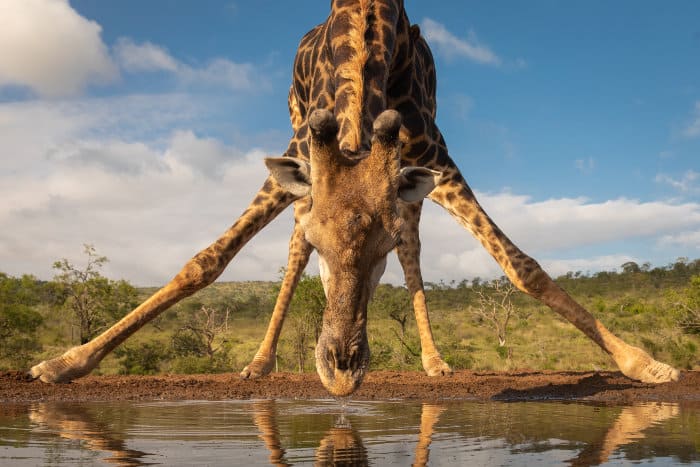
Ossicones derive their name from the Latin word ‘os’, meaning bone, and the Middle French word ‘cone’, which refers to a peak or cone. Giving them the pleasing English translation ‘bone cones’, which is rather apt.
However, ossicones are not actually made of living bone. Instead, they comprise ossified cartilage, which is cartilage that has effectively turned into hard, bone-like tissue.
They differ from horns and antlers in that skin and fur cover them, as opposed to velvet or keratin. In addition, ossicones are not subject to seasonal shedding, which is the hallmark of the antler.
These horn-like protuberances are unique to giraffes, okapis, and a few of their long-extinct cousins.
Why Do Giraffes Have Horns?
So, what are giraffe horns for?
They don’t seem large or sharp enough to prove as weapons. Yet evolution tells us that they must have been useful at some point in time.
Let’s take a closer look.
What are ossicones used for?
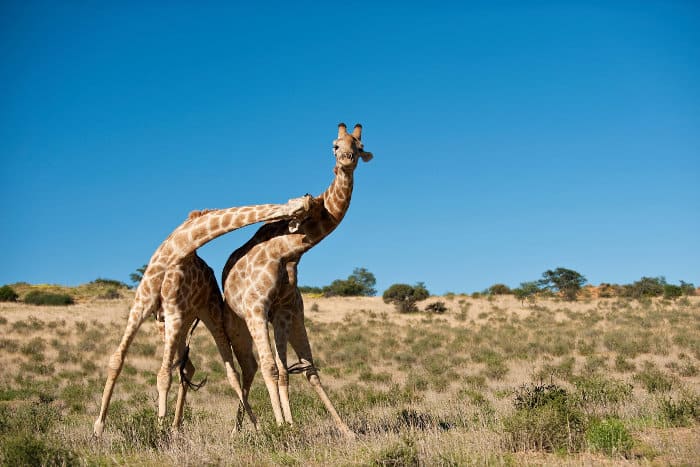
The truth is, no one really knows why exactly giraffes have ossicones. It seems likely that they are remnants of more useful appendages, found in distant ancestors. Possibly protrusions to which something larger attached to the head.
However, while they don’t seem to play a vital role in modern giraffes, male giraffes do have a use for their ossicones. The boney antennae add weight to the head, which proves useful in combat.
Male giraffes fight by swinging their long necks, colliding their heads against their opponents. As such, having a pointy pair of protrusions, as well as a bit of extra weight, is something that adds an advantage.
Remember the furless ossicones of male giraffes? Necking is the real culprit. Years of knocking noggins with other males wears away the fur and skin, until their ossicones become bald.
The Only Mammal Born with Horns
![]()
It can’t be safe (or comfortable) to give birth to a calf with a sharp set of horns. So it’s understandable that this is not a common occurrence in the animal kingdom. In fact, giraffes are the only animal born with horns.
Fortunately for mother giraffes, however, the protrusions have a clever way of protecting both parties. At birth, the ossicones are not attached to the skull.
This allows them to lie flat on the head of a baby giraffe (which is undeniably the cutest animal on the savannah).
In addition, the ossification process begins after birth, so the ossicones are still soft cartilage at this stage.
In time, however, the ossicones fuse to the skull and harden, giving grown-up giraffes their characteristic crowns.
Okapi Ossicones
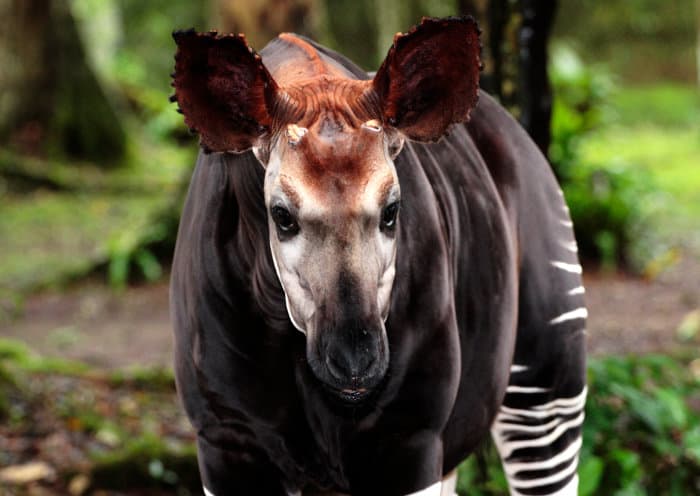
Okapis are strange yet wonderful creatures that appear to be part zebra, part antelope, and part giraffe. Their rears and legs have white stripes, while the rest of their bodies are plain chocolate-brown.
They are the only other living animals that have ossicones. In fact, they are the only living relative of giraffes. However, when it comes to horns, theirs are a little different from those of their lanky cousins.
To start, it is only male okapis who possess these distinctive horns. Female okapis have small knobbly bumps and characteristic hair whorls instead.
In addition, unlike giraffes, male okapis are not born with their horns. Their ossicones generally take one year to develop fully after birth, and grow to around 15 cm in length. And the tips are not covered in skin.
Also known as the ‘forest giraffe’, okapis are endemic to the central and north-eastern regions of DRC. There, they live in thick, lowland rainforests, where they blend expertly into their surroundings.
The Ossicones of Extinct Cousins
While giraffes and okapis are the only living animals with ossicones, some of their distant cousins had them too.
These long-extinct animals are fascinating, and their ossicones are even more curious than those of giraffes.
Sivatherium
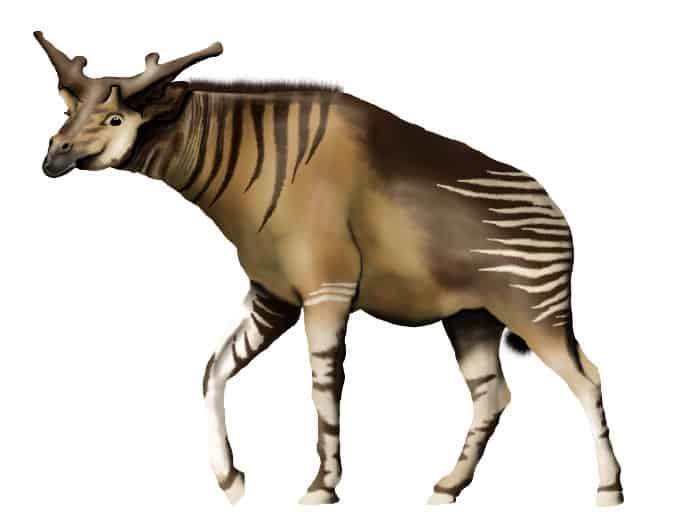
Sivatheriums roamed the Earth until around 10 000 years ago when they went extinct at the end of the last ice age.
Scientists have estimated that they likely weighed up to 1533 kg. This would make them the largest giraffids (of the Giraffidae family) that ever existed. As well as the largest ruminants on record.
While modern giraffes are taller, sivatherium was likely a lot stockier, which accounts for their extra weight.
Their ossicones were also more impressive.
They had two sets; one smaller pair of horn-like ossicones above their eyes, and a larger set above their ears, that are more resemblant of antlers. This impressive crown seems more like a weapon than the horns of today’s giraffes.
Climacoceratidae
Another distant cousin of the giraffe is a family of animals called Climacoceratidae. This group of species was convincingly deer-like in appearance. However, they are far more closely related to giraffes.
The Climacoceras africanus and the Climacoceras gentryi were the two species of Climacoceratidae that most closely resembled deers.
Their ossicones were particularly strange. Made of several bones, these antler-like appendages looked like thorny plants. Those of the africanus were relatively straight, albeit spikey. And those of the gentryi were starkly crescent-shaped.
Ossicones: The Cherry On Top of a Curious Creature
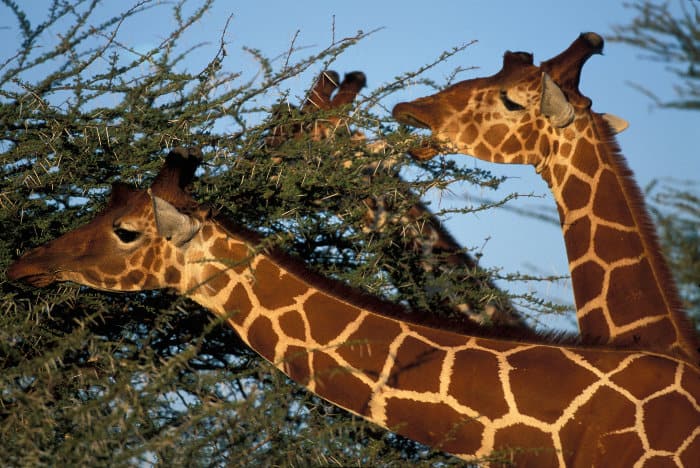
So, it seems that there’s more to the humble giraffe horn than most people know.
These horns not only add a unique touch to the faces of a favorite safari animal. Giraffes’ ossicones can help us identify their sex, and whether or not they’re an avid fighter. They can help us to recognize different species, too.
They tell stories of a distant past, and of the way giraffes live their lives. Stories that shed light on creatures of a different era, and of the little-known okapis that still live in Africa today.
So, if you ever book an African safari to see a giraffe in person, you’ll have plenty of giraffe facts to share with your loved ones along the way.
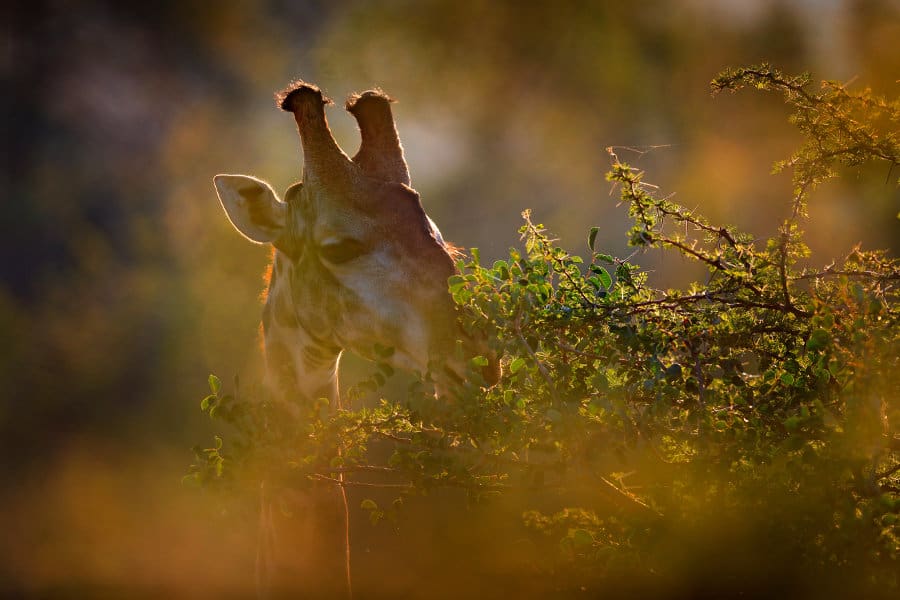
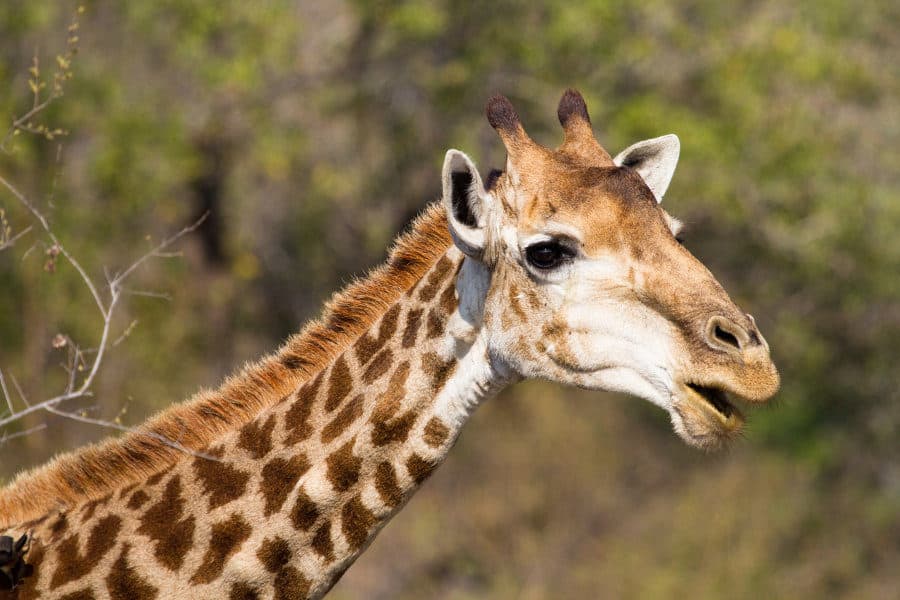


I think the giraffe is such a graceful and peaceful creature.